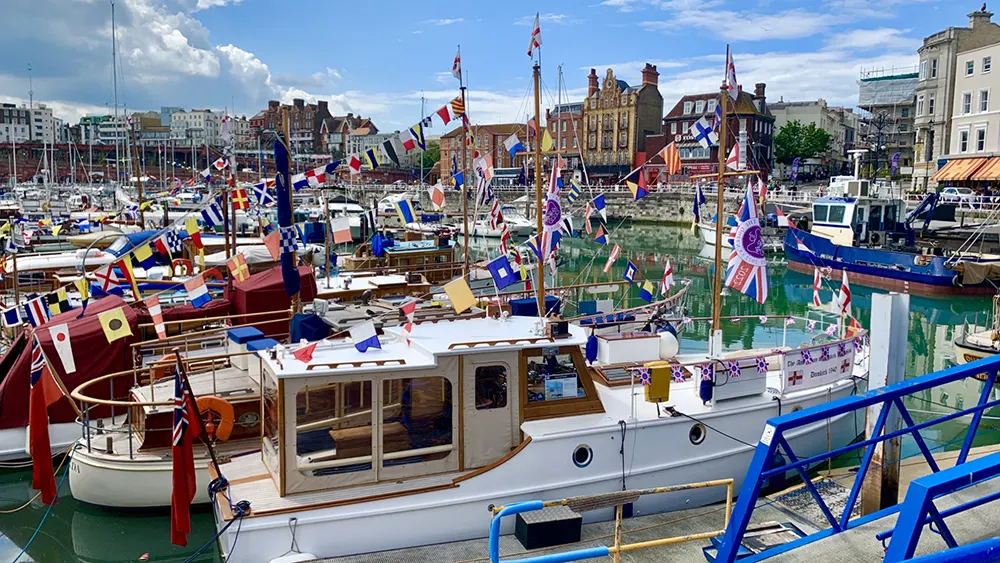RAMSGATE’S ROYAL HARBOUR GRANTED OFFICIAL HERITAGE HARBOUR STATUS
In July 2024, Ramsgate’s Royal Harbour became a national Heritage Harbour, only one of fourteen locations across the United Kingdom to receive this important designation. The Ramsgate Society runs the Ramsgate Heritage Harbour group.

Ramsgate’s Royal Harbour marina and the arches of Military Road at dusk.
Credit: ©Tourism @ Thanet District Council
HERITAGE HARBOURS is a joint initiative between Historic England, the Maritime Heritage Trust and National Historic Ships and local groups. Its aims include: protecting heritage assets at risk; attracting investment and heritage funding, supporting local business growth; increasing tourism; and improving community cohesion and inclusion.
Heritage Harbours supports the safeguarding and conservation of the UK’s most historic coastal and waterway locations, along with the buildings, quays, shipyards, and environments that make them special. They are where you can see traditional ships and boats still in operation, and the buildings, facilities and people that make this possible.

A fishing boat returning to port, passing a visiting tall ship moored in Ramsgate’s Royal Harbour, with the Georgian terraces of Nelson Crescent and Paragon on the West Cliff above.
Credit: ©CCwikicommons-GuySawtell
DUNKIRK “LITTLE SHIPS”
In spring 2025 Ramsgate’s Royal Harbour will host the 85th anniversary return of the Dunkirk ‘Little Ships’, with more than 50 of the original vessels that took part in “Operation Dynamo” to bring Allied soldiers back from beaches in France, together with around 100 other historic watercraft.
The Royal Temple Yacht Club was the base for coordinating the ‘Little Ships’ and now hosts the south coast’s popular ‘friendly’ annual regatta – Ramsgate Week. The event welcomes crews from across the globe and has been running for over 120 years.

Dunkirk “Little Ships” moored in the Inner Basin of Ramsgate’s Royal Harbour
Credit: ©CCwikicommons-GuySawtell
HISTORIC VESSELS IN RAMSGATE ROYAL HARBOUR
Ramsgate’s Royal Harbour is home to many historic boats and ships on the National Register of Historic Vessels, including the steam tug Cervia and the trawler Starbuck. A regular mooring for others, the historic tall ship Bessie Ellen and replica vessels, Thames sailing barge, The Blue Mermaid, and Spanish Galeón Andalucía have already docked and invited visitors on board in 2024. Plans are being drawn up to welcome more heritage vessels and to host regattas and other events for historic ships and boats in the Royal Harbour in the future.
CLOCK HOUSE MUSEUM
The Georgian Grade II* Clock House dominates the quayside. In 1819 it was the endpoint for Ramsgate’s own meridian line – 5′41″ahead of Greenwich Mean Time. Today it is the home of the Clock House Museum, reopening in 2026 with objects and stories from across the history of the Royal Harbour. Until then, exhibitions and events will be at various venues in and around the Royal Harbour: search for “Clock House Ramsgate” on Facebook.

The Georgian Clock House, situated next to Smeaton’s Dry Dock, at the entrance to the East Pier and East Cross Wall in Ramsgate’s Royal Harbour
Credit: ©CCwikicommons-GuySawtell
RAMSGATE’S ROYAL HARBOUR
The Grade II* listed harbour and is the only royal harbour in the world, an honour bestowed by King George IV in 1821. Its history dates back to before Roman times, but it has always played a major part in the area’s commercial, military, and tourist activities. In the Napoleonic wars it was a base for the Sea Fencibles (naval defence units), and in the First World War for the Dover Patrol. During the Second World War it was the landing place for many of those soldiers brought home from Dunkirk by the ‘Little Ships’.

Ramsgate Royal Harbour, constructed between 1749 and 1792, with the Wyatt and Shaw designed 1842 lighthouse at the end of the West Pier.
Credit: ©Tourism @ Thanet District Council
The construction of the Royal Harbour in its present form began in earnest after a violent storm in December 1748 led ships in the Downs (between the Goodwin Sands and coast) to seek shelter at Ramsgate. Many vessels and lives were saved and petitions were made to Parliament for Ramsgate as the site for a new harbour to provide a refuge for those in need.
Today the Royal Harbour combines the maritime heritage with the activities of a 21st century harbour and a thriving waterfront café culture. Windfarm operations, a RNLI station, shipbuilders, boat yards and a local fishing fleet are neighbours to a Georgian powder store and the 18th century Smeaton crosswalls, sluices and dry dock. The Victorian architecture of the Royal Temple Yacht Club, the Sailor’s Church and Smack Boys’ Home sits side-by-side the many restaurants and bars that line the water’s edge.

The Sailors’ Church, Home for Smack Boys, and Jacob’s Ladder leading up to the Georgian town houses overlooking Ramsgate’s Royal Harbour
Credit: ©CCwikicommons-GuySawtell